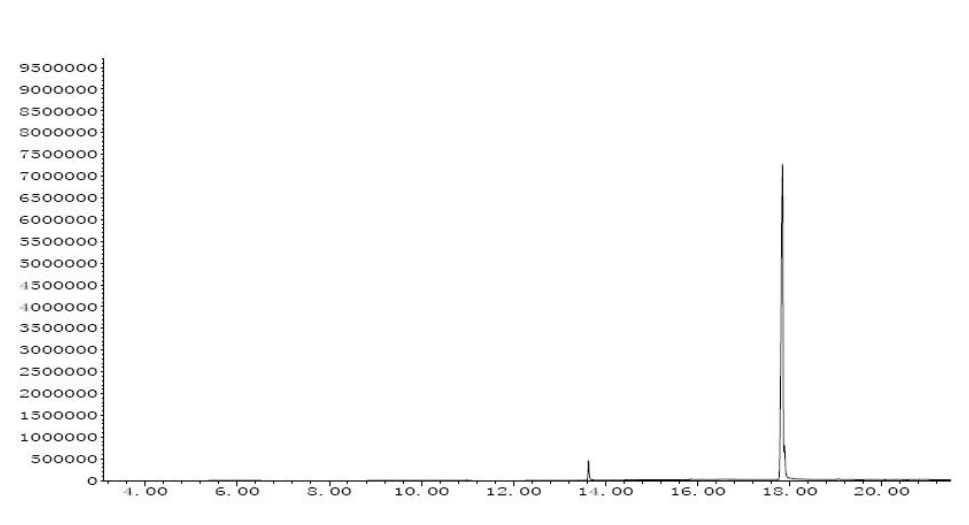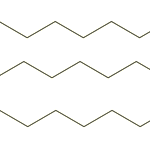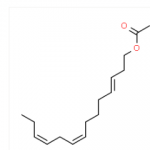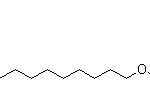cis-9-Tricosene CAS#: 27519-02-4; ChemWhat Code: 77944
Identification
| Product Name | cis-9-Tricosene |
| IUPAC Name | (Z)-tricos-9-ene |
| Molecular Structure | |
| CAS Registry Number | 27519-02-4 |
| Synonyms | (Z)-tricos-9-ene, cis-tricos-9-ene, (Z)-9-Tricosene, 9-(Z)-tricosene, cis-9-tricosene, 9-tricosene, muscalure; CAS Number: 27519-02-4 |
| Molecular Formula | C23H46 |
| Molecular Weight | 322.611 |
| InChI | InChI=1S/C23H46/c1-3-5-7-9-11-13-15-17-19-21-23-22-20-18-16-14-12-10-8-6-4-2/h17,19H,3-16,18,20-23H2,1-2H3/b19-17- |
| InChI Key | IGOWHGRNPLFNDJ-ZPHPHTNESA-N |
| Canonical SMILES | CCCCCCCCCCCCC/C=C\CCCCCCCC |
| Patent Information | ||
| Patent ID | Title | Publication Date |
| US4670250 | Durable controlled release microcapsules | 1987 |
| US5888930 | Asymmetric microporous beads for controlled release | 1999 |
| US5399344 | Synergistic fly attractant composition | 1995 |
Physical Data
| Appearance | Colorless or light yellow oil |
| Solubility | Miscible with water and hexane. Immiscible with alcohol. |
| Refractive index | n20/D 1.453(lit.) |
| Melting Point, °C |
| 4 |
| 27 – 28 |
| -1 |
| Boiling Point, °C | Pressure (Boiling Point), Torr |
| 156 – 157 | 0.1 |
| 70 – 90 | 0.1 |
| 170 | 0.1 |
| 180 | 1 |
| 140 – 142 | 0.01 |
| 148 – 150 | 0.04 |
| 136 – 140 | 0.1 |
| Refractive Index | Wavelength (Refractive Index), nm | Temperature (Refractive Index), °C |
| 1.4515 | 589 | 26 |
| 1.4543 | 589 | 20 |
| 1.4559 | 589 | 20 |
| 1.4522 | 589 | 20 |
| 1.4488 | 589 | 20 |
| 1.4545 | 589 | 20 |
| 1.4532 | 589 | 23 |
Spectra
| Description (NMR Spectroscopy) | Nucleus (NMR Spectroscopy) | Solvents (NMR Spectroscopy) | Frequency (NMR Spectroscopy), MHz |
| Chemical shifts | 1H | chloroform-d1 | 300 |
| Chemical shifts | 13C | chloroform-d1 | 75 |
| Spin-spin coupling constants | CDCl3 | ||
| Chemical shifts | 1H | CDCl3 | 200 |
| Chemical shifts | 13C | CDCl3 | 22.5 |
| Chemical shifts | 1H | CCl4 | |
| Spectrum | 1H | CDCl3 | |
| NMR |
| Description (IR Spectroscopy) | Solvent (IR Spectroscopy) | Comment (IR Spectroscopy) |
| Bands | film | |
| Spectrum | KBr | diagram |
| Bands | neat (no solvent) | 3006 – 721 cm**(-1) |
| Bands | neat (no solvent) | 735 cm**(-1) |
| Bands | neat (no solvent) | 1650 – 712 cm**(-1) |
| IR |
| Description (Mass Spectrometry) |
| gas chromatography mass spectrometry (GCMS), electron impact (EI), spectrum |
| gas chromatography mass spectrometry (GCMS), spectrum |
| high resolution mass spectrometry (HRMS), electron impact (EI), spectrum |
| spectrum, electron impact (EI) |
| spectrum, chemical ionization (CI) |
| chemical ionization (CI), spectrum |
| electron impact (EI), spectrum |
Route of Synthesis (ROS)
| Conditions | Yield |
| With hydrogen; Pd-Pb-CaCO3 (Lindlar catalyst) In hexane | |
| With 9-borabicyclo[3.3.1]nonane dimer; acetic acid 1) THF, 0 deg C, 24 h, 2) reflux, 5 h; Yield given. Multistep reaction; | |
| With methanol; 9-borabicyclo[3.3.1]nonane dimer; acetic acid 1.) THF, 0 deg C, 48 h, 2.) 25 deg C, 1 h; Yield given. Multistep reaction; | |
| With quinoline; hydrogen; Pd-BaSO4 In Petroleum ether Ambient temperature; | |
| With iron(II) acetylacetonate; hydrogen; diisobutylaluminium hydride In tetrahydrofuran; toluene at 30℃; under 975.098 Torr; for 12h; Sealed tube; stereoselective reaction; | n/a |
Safety and Hazards
| Pictogram(s) |  |
| Signal | Warning |
| GHS Hazard Statements | H317: May cause an allergic skin reaction [Warning Sensitization, Skin] Information may vary between notifications depending on impurities, additives, and other factors. |
| Precautionary Statement Codes | P261, P272, P280, P302+P352, P321, P333+P313, P363, and P501 (The corresponding statement to each P-code can be found at the?GHS Classification?page.) |
Other Data
| Transportation | NONH for all modes of transport |
| Under the room temperature and away from light | |
| HS Code | 290129 |
| Storage | Under the room temperature and away from light |
| Shelf Life | 1 year |
| Market Price | USD |
| Druglikeness | |
| Lipinski rules component | |
| Molecular Weight | 322.618 |
| logP | 12.911 |
| HBA | 0 |
| HBD | 0 |
| Matching Lipinski Rules | 3 |
| Veber rules component | |
| Polar Surface Area (PSA) | 0 |
| Rotatable Bond (RotB) | 19 |
| Matching Veber Rules | 1 |
| Bioactivity |
| In vitro: Efficacy |
| Quantitative Results |
| Quantitative Results | ||
| 1?of?6 | Assay Description | Effect : electrophysiological Target : Idea leuconoe, giant danaine butterfly Bioassay : electroantennography; antennae of 10- to 14-day-old adults; 2 ml odor puff; continuous airflow (350 ml/min); 1 cm from the antennal preparation; EAG response relative to 1-hexanol (100 percent); n = 10-11 |
| Results | relative response: ca. 30 percent at 0.1 μg, ca. 35 percent at 1.0 μg | |
| 2?of?6 | Assay Description | Effect : electrophysiological Target : Idea leuconoe, giant danaine butterfly Bioassay : electroantennography; antennae of 10- to 14-day-old adults; 2 ml odor puff; continuous airflow (350 ml/min); 1 cm from the antennal preparation; EAG response relative to 1-hexanol (100 percent); n = 10-14 |
| Results | relative response: ca. 35 percent at 0.1 μg, ca. 42 percent at 1.0 μg | |
| 3?of?6 | Effect | pheromone |
| Assay Description | Target : Lygocoris pabulinus (L.), green capsid bug Bioassay : vibration of abdomen of male bugs observed; controls: extract of legs of male bugs; this extract + 5 μg (Z)-9-heptacosene; positive control: extract of legs of female bugs virgin bug 6-9 days old (N=32); legs of male bugs loaded with 1 μg title comp. and 5 μg (Z)-9-pentacosene placed in Petri dish; one male per dish introduced; 19 – 23 deg C | |
| 4?of?6 | Effect | Reproductive Effect |
| Assay Description | Target : Varroa destructor Anderson and Trueman, mite Bioassay : inhibition of reproduction of Varroa destructor mite reared on Apis mellifera larva in artificial cells studied; control: hexane; RH: relative humidity title comp. applied to interior of 6.5 mm gelatin cells, then 1 mite and bee larva inserted into each cell; incubator, 34.5 deg C, 75 percent RH, 10 days; then cells opened; presence and number of offsprings per mite in each cell noted | |
| 5?of?6 | Effect | repellent agent |
| Assay Description | Target : Bombus lapidarius (L.), bumblebee Bioassay : controls: not treated flowers and treated with pentane test comp. dilution 10-12?μg/5 ml pentane; appled to Melitotus officinalis flowers; offered to bumblebees | |
| Results | rejection of flowers by B. lapidarius (diagram) | |
| 6?of?6 | Results | sex pheromone of Musca domestica |
| In vivo: Animal Model |
| Quantitative Results |
| pX | Parameter | Value (qual) | Biological Species |
| 1 | Percentage change(of % courtship and amount of courtship behaviour) | Not active | Drosophila suzukii |
| 1 | percentage decrease(of copulation) | Active | Drosophila suzukii |
| Use Pattern |
| Agricultural use |
| inhibits mating |
| pest control agent against Drosophila suzukii |
| Attractant for fly gel |
| Attractant for an insect trap functions |
| arresting effect on insects |
| Fights against social, sub-social or gregarious insects |
| pheromone |
| chemical attractant |
Related Chemicals
Buy Reagent | |
| No reagent supplier? | Send quick inquiry to ChemWhat |
| Want to be listed here as a reagent supplier? (Paid service) | Click here to contact ChemWhat |
Approved Manufacturers | |
| Watson Bio Ltd | https://www.watson-bio.com/ |
| Want to be listed as an approved manufacturer (Requires approvement)? | Please download and fill out this form and send back to approved-manufacturers@chemwhat.com |
Contact Us for Other Help | |
| Contact us for other information or services | Click here to contact ChemWhat |








![Structure of 4-[4-(acetyloxy)phenyl]-2-butanone CAS 3572-06-3](https://www.chemwhat.com/wp-content/uploads/2017/11/Structure-of-4-4-acetyloxyphenyl-2-butanone-CAS-3572-06-3-150x89.png)

